- You are here:
- Home »
- Cauchi
Tag Archives for " Cauchi "
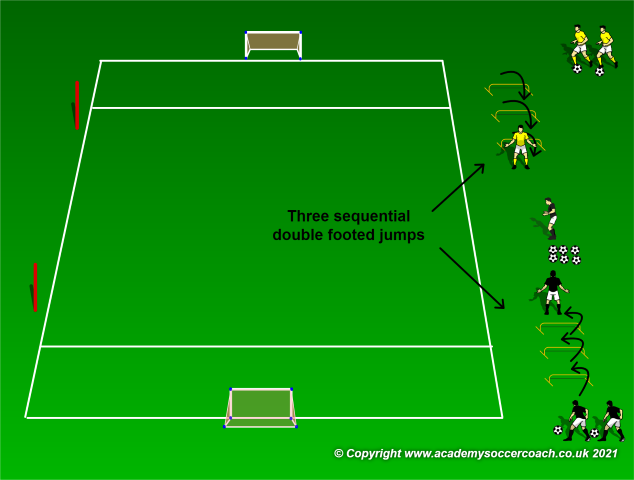
1v1 Conditioning Drill
By Philip Cauchi
Title: Combined strength in the 1v1.
Aim: To develop soccer-specific strength in the duel.
Organization: Mark an area measuring 12 yards by 8 yards with a mini goal post at both ends. A scoring zone is to be marked 2 yards from both ends. On one side of the area are 2 sets of three hurdles set in a line. The height of the hurdles vary but should not be too high in that it might cause injuries. The 2 sets of hurdles face each other approximately 5 yards apart.
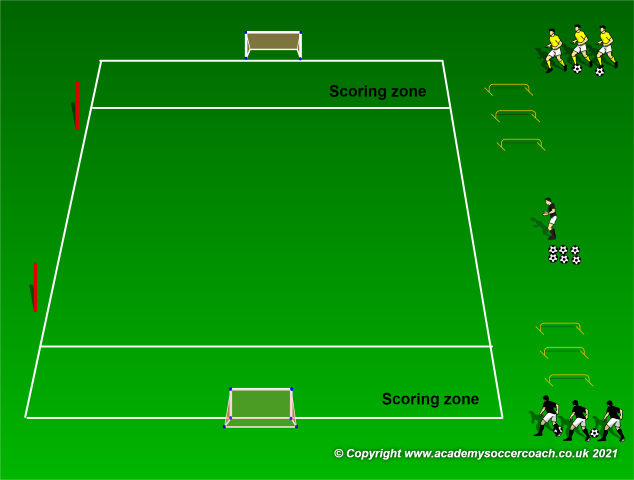
The exercise starts on the coach’s signal. A player from each group makes three consecutive two-footed jumps over the hurdles. This is not a race and it should be stressed out to the players as more important than the power generated through each jump we seek correct movement.

When the final jump is completed the players open up to receive the ball from their teammate next in line. The players should receive the ball facing forward and controlling it using their backfoot.
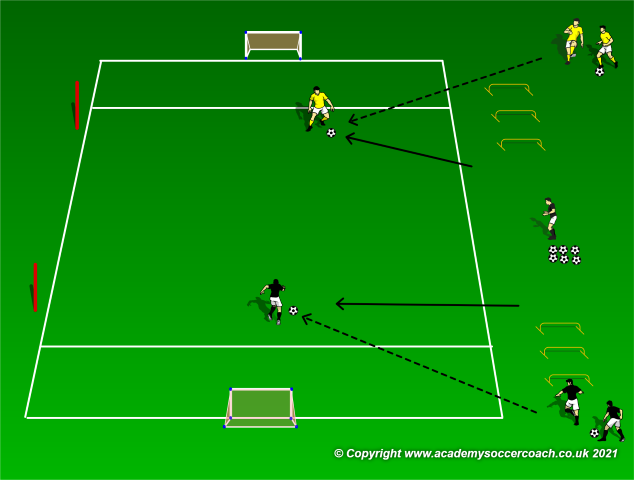
After controlling the ball the players should dribble towards and around their assigned pole before kicking the ball into the respective mini goalpost.
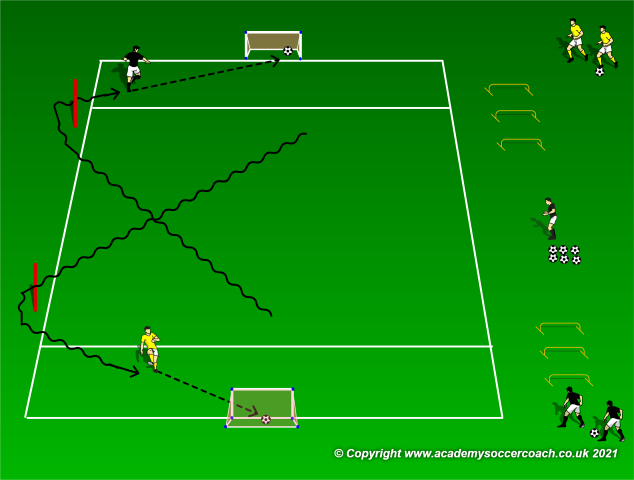
After kicking the ball into the mini goal post, the coach passes to any of the two players who play a 1v1 duel. The players can only score from inside their assigned scoring zone. The game is on until the ball goes out of play or a goal is scored.
Training load:
Sets: 2.
Repetitions: 4 to 6.
Duration for each repetition: 20 seconds to 25 seconds.
Rest between repetitions: 60 seconds.
Rest between sets: 4 minutes.
By Philip Cauchi
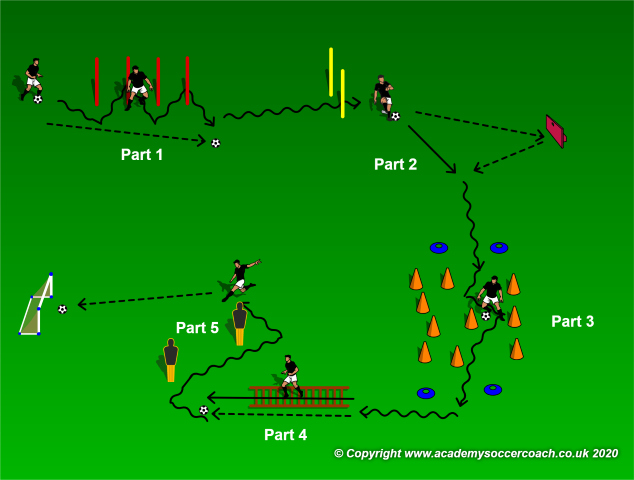
Five Part Speed and Agility Course
By Philip Cauchi
Title: Technical and rapidity parcourse.
Theme: Speed, agility and quickness.
Development of the soccer domains:
Technical-tactical: Dribbling, controlling the ball and kicking.
Mental: Maintain focus.
Socio-psychological: n/a.
Physical: Perform rapid movements with and without the ball.
Organisation: We have five setups (or parts) as shown in the below diagram. In part one there are four poles positioned one yard apart and in a line. In part two there are two poles positioned one yard apart and a passing wall board set eight yards from these two poles. In part three we have a number of cones scattered and two gates made of markers. One is the entry gate while the other is the exit gate. In part four we have an agility ladder, while in part five we have two mannequins positioned at an angle from each other and five yards from the mini goal.
Description: The exercise is divided into five parts as described hereunder. These are stations which the player must complete in sequential order.
Part 1: Self-pass the ball, slalom around the poles to receive and control the ball.
Part 2: The player dribbles through the gate and passes against the wall board to receive and control the ball.
Part 3: The player enters the station from between the entry gate (marked with blue markers) and dribbles around the cones to exit from the opposite gate (also marked with blue markers).
Part 4: Before performing quick footwork using the agility ladder, the player self-passes the ball and controls at the end.
Part 5: The player performs a feint at each mannequin prior to finish with a well-aimed pass on the mini goal.
Training load: Each player should perform the circuit between six to eight times with a one minute rest in between. The par-course should take between twenty and twenty five seconds to complete.
Periodization: This practice is ideal as a recovery session. The level of complexity, the intensity and also the duration is low.
Variations: Players can perform different types of footwork on the agility ladder. They can also pass using the left of right foot, dribble using different parts of the same foot and perform different agility movements.
1
The initial set up of the par-course. Variations of the set up may be applied to introduce different movements.
By Philip Cauchi
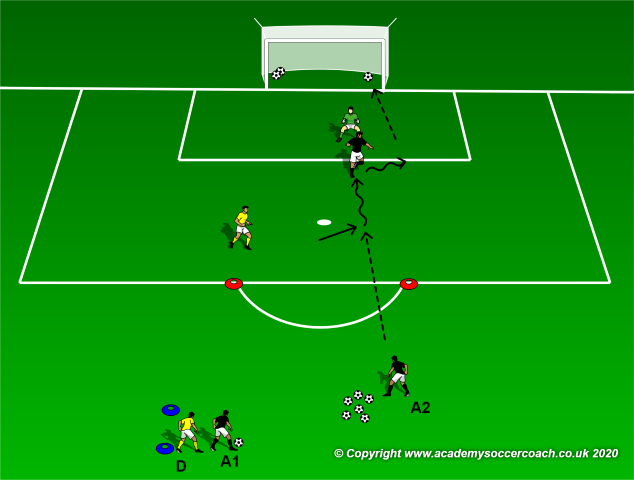
1v1 to Goal Conditioning
By Philip Cauchi
Title: 1v1 duel to finish on goal.
Theme: Strength endurance in the duel.
Development of the soccer domains:
Technical-tactical: Receiving with a good first touch, dribbling and controlling the ball under opposition pressure and finishing on goal with accuracy and power.
Mental: Maintain a positive mentality to dribble past the defender and conclude on goal.
Socio-psychological: Communicate with teammate (mostly non-verbal) where the ball should be passed and received.
Physical: Resist opposition pressure to conclude at goal while maintaining balance and quality of movements with the ball.
Organisation: The area of practice is the whole penalty area. The players are divided into three groups of which two are forwards (blacks) and the other defenders. All the players are positioned approximately ten yards in front of the penalty area as shown in the first diagram. A goalkeeper is in goal and forwards A1 and A2 both start with a ball. Forward A2 has a number of balls at his disposal as needed for the practice.
Description: The exercise is divided into three parts as described hereunder.
Part 1: Forward A1 dribbles forward while under pressure from the defender. Forward A1 can only score once inside the penalty area and by dribbling between the markers (diagram 2).
Part 2: When the first part is over, forward A1 receives a pass from A2 with his back to the goal while the defender applies pressure on him. Forward A1 must find a way to turn and conclude at goal (diagram 3).
Part 3: Upon completing the second part, forward A1 receives the ball from A2 and play a 1v1 against the goalkeeper (diagram 4).
Once these actions are all over, the forwards switch roles.
Training load: Each forward should go through the above process for two sets of four to eight repetitions each. The rest between repetitions should be two minutes as the total duration of each repetition is approximately thirty to forty seconds. The rest between sets should be of four minutes so to ensure a high quality output of soccer actions.
Periodization: This session should take place at least seventy two hours following the previous match (MD+3) and not less than seventy two hours prior to the last match. This applies only for those players who played a substantial amount of minutes in the previous match. Those who did not take part in the match or played just for a few minutes (duration depends on the intensity of the match), can perform this practice even the day after.
Targeted energy system: Accumulation of lactic acid may occur during the practice. This and the body’s ability to quickly remove a high amount of lactic acid during the rest periods depends on the level of soccer fitness of the players.
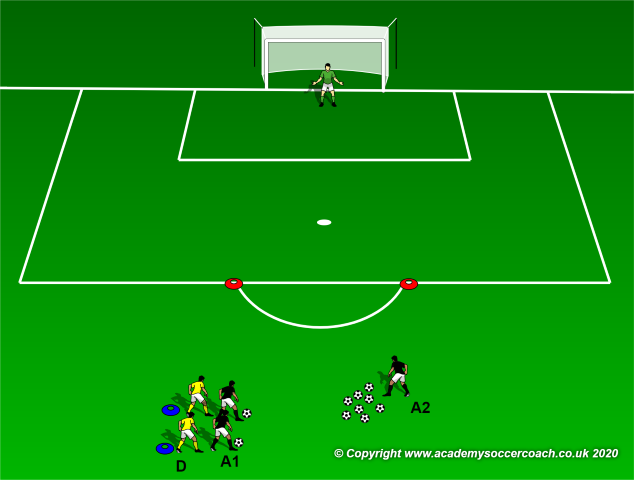
Diagram 1: The initial set up of the practice.
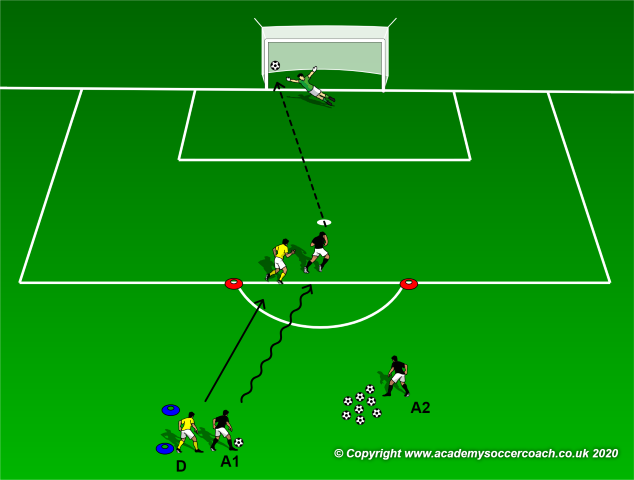
Diagram 2: Forward A1 dribbles forward to shoot at goal while under pressure.
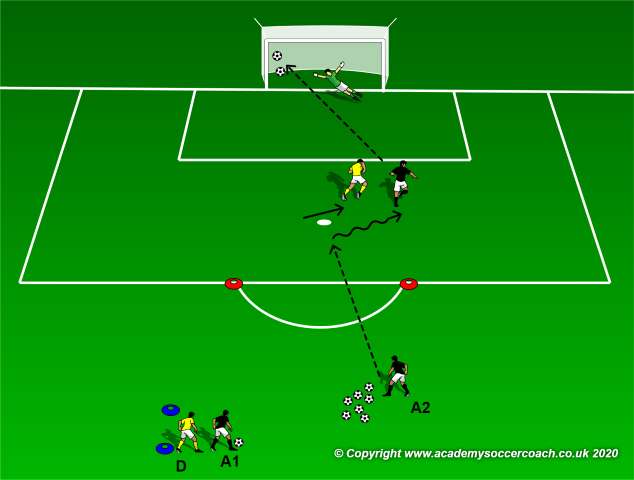
Diagram 3: Forward A1 receives the ball from A2 with his back to the goal.

Diagram 4: Forward A1 receives the ball from A2 to play 1v1 against the goalkeeper.
By Philip Cauchi

1v1s For Soccer Speed
By Philip Cauchi
Title: Soccer specific speed in a 1v1 situation.
Theme: Soccer speed with the ball.
Development of the soccer domains:
Technical-tactical: Run fast with the ball, keep control of the ball and accuracy in the shot.
Mental: Focus on finishing the attack even while under pressure from the defender.
Socio-psychological: N/A.
Physical: Quality of soccer sprinting actions while in control of the ball.
Organisation: Area measuring 12 yards plus an additional 3 yards scoring zone for a total of 15 yards in length measuring by 10 yards in width. At one end of the area two mini goals are positioned four yards from each other. The two players, the attacker and the defender start four yards apart with the attacker with a ball at his feet. After each repetition, the two players switch roles.
Description: At the attacker’s discretion he starts dribbling forward. The defender must quickly react to the movement by the attacker and immediately starts defending against him. The attacker is only allowed to score from inside the scoring zone. If the defender wins the ball, he scores by passing the ball in any of the two mini goals.
Training load: Two sets of four to six repetitions each. Rest between thirty and forty seconds between repetitions and for two minutes between sets.
Periodization: This session should take place 48 hours prior to the next match (MD-2).
Targeted energy system: Anaerobic alactic energy system targeting minimal accumulation of lactic acid so that the quality of soccer sprints remains high.
Progressions:
1. The attacker and the defender start from different starting positions.
2. The attacker scores on one mini goal.
3. The attacker plays the ball to the target player, then sprints to receive and finish on goal. The attacker finishing on target becomes the new target player.
4. The attacker tries to score against two recovery defenders.
5. As in progression 3 but the attacker is immediately followed and contrasted by two defenders.
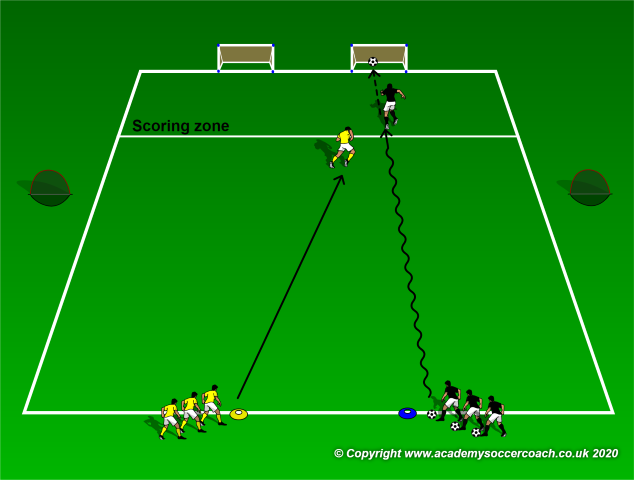
The attacker with the ball dribbles forward to score in any of the two mini goals.
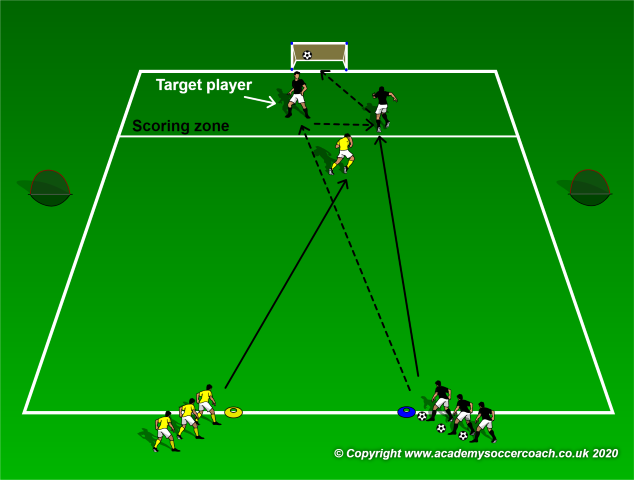
Progression 3: Playing the ball to the target player prior to finishing on goal.
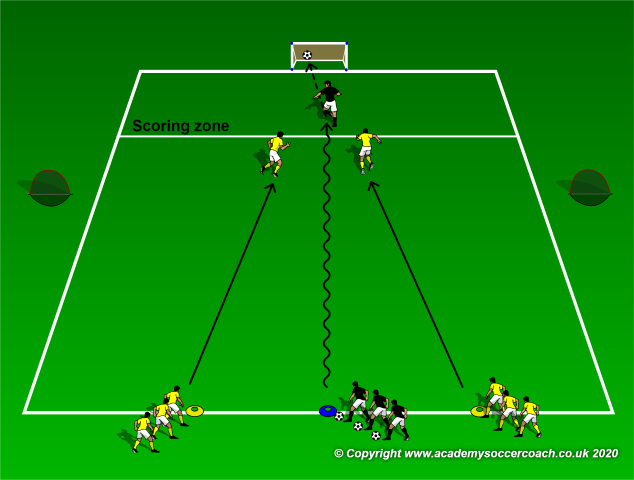
Progression 4: Dribbling at speed to score against two defenders.
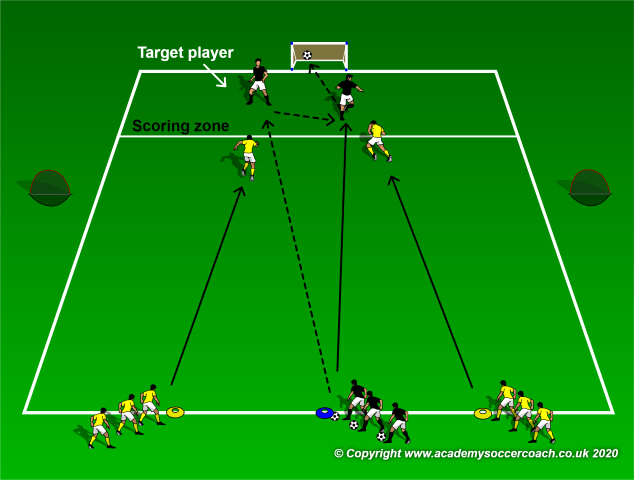
Progression 5: The attacker follows the forward pass while pressured by two defenders.
By Philip Cauchi
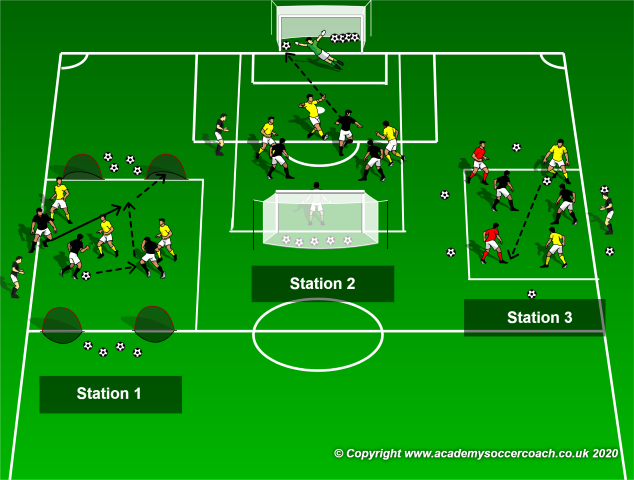
Aerobic Circuit With a Ball
By Philip Cauchi
Title: Soccer specific aerobic circuit.
Theme: Maintain the quality of soccer actions.
Development of the soccer domains:
Technical-tactical: Concepts of triangles, distances and angles, space creating and quick ball circulation.
Mental: Attitude towards winning the ball immediately upon losing it.
Socio-psychological: Communication (verbal and visual) and collaboration.
Physical: Maintain the quality of soccer actions high even after a prolonged period of time.
Organisation: Three stations are to be organised as shown in the diagram. Station 1 is a game of 3v3 on four mini goals. The area for this station is 30 yards by 20 yards. Station 2 is a 3+GKv3+GK on two regular goalposts. The goalkeepers always remain in this station. The dimensions for the area are 30 yards by 20 yards. Station 3 is a 2v2+2 transitional rondo. The dimensions for the area are 10 yards by 8 yards. A large number of balls should be positioned around the stations so to allow a high flow of the training session.
Description: In station 1 each team defends two mini goals positioned on the same line and attacks the opposite two. In station 2 a normal game is played where each team attacks one goal and defends the opposite. No corner kicks or throw-ins are in effect. If the ball goes out of play, restart takes place from the goalkeeper of the team in possession. In the 2v2+2 transitional rondo in station 3, two teams aim to keep the ball against the third team. Upon losing possession, the two attacking teams apply immediate pressure on the ball as the defending team can only change roles with the attacking team losing the ball if they succeed in dribbling the ball out of the area.
Training load: Play for two minutes at each station, rest for one minute and then move to the next station. Players rest for two minutes between circuits. The circuit should be repeated for four to six times depending on the fitness level of the players.
Periodization: This session should take place at least 72 hours following the previous match (MD+3) and at least 72 hours prior to the next one (MD-3).
Targeted energy system: Aerobic energy system, moving into a higher concentration of blood lactate at the latter part of the session.
Training considerations: The players who have not taken part or played a sufficient part in the previous match can still train at this intensity the day after the match.

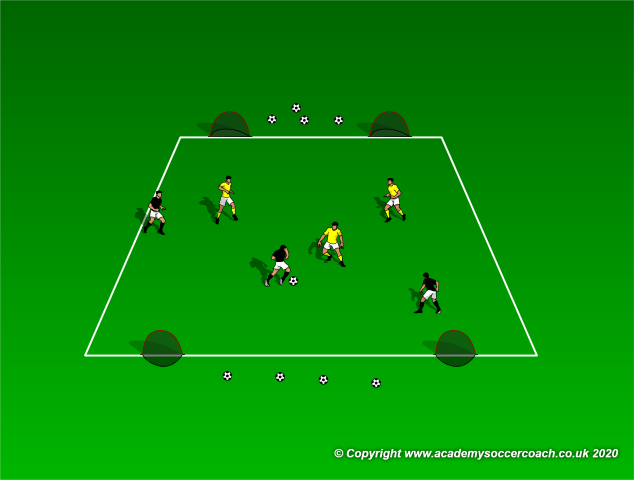
Station 1: 3v3 on four mini goals
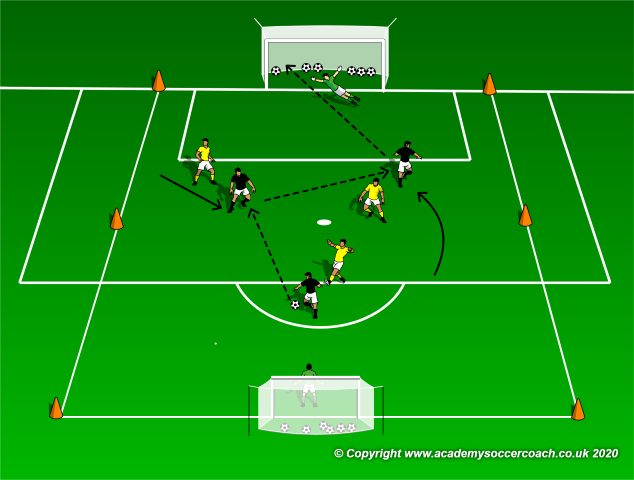
Station 2: 3v3 shooting game.
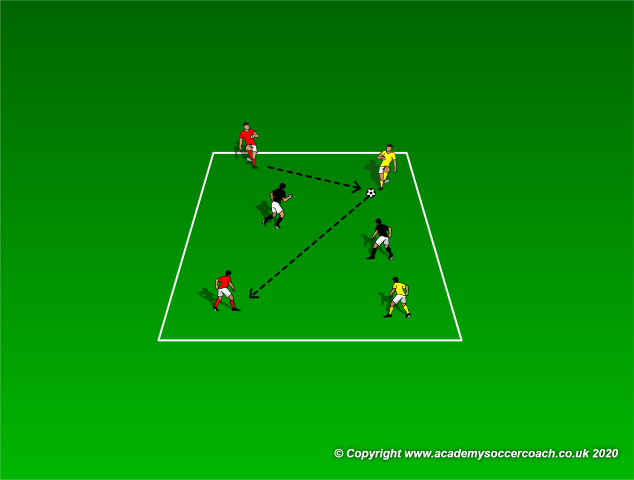
Station 3: 2v2+2 transitional rondo.
By Philip Cauchi

Conditioning With Quick Transition Game
By Philip Cauchi
Title: Quick transitions.
Theme: High intensity intermittent.
Development of the soccer domains:
Technical: Passing, dribbling, running with the ball and shooting.
Tactical: Attacking in a numerical superiority and defending in a numerical advantage.
Socio-psychological: Concentration, composure, quick decision-making, communication and collaboration.
Physical: Quick recovery between soccer actions.
Organisation: The practice area should measure 40 yards in length by 30 yards in width which is divided into two equal horizontal zones. The regular goalposts are positioned at both ends of the practice area. A goalkeeper is positioned in each of the two goals. We have two teams positioned at opposite ends. The yellow team is further divided into three subgroups while the black team is divided into two subgroups. One of the players of both teams has a ball at his feet.
Description: The two attackers (blacks) start either by passing the ball or dribble forward against the single defender. After the attack is over, teams switch roles and two players for the yellow team come into play, one of them with a ball. Now the yellows attack the blacks in a 3v2 with a numerical advantage in their favour. Scoring can only occur from inside the attacking half of the practice area. The offside rule is in effect from inside the attacking half for both the 2v1 and the 3v2 situations. If the defenders win the ball a quick transition occurs with the aim of scoring. Teams change positions after each series. Furthermore, after each attack the players from each team change their position. In this case the yellow team players will move one position to their right.
Training load: This obviously depends on the conditioning level of the players at your availability. However in this article we will go with the example of having four series of three minutes each with a two minute active rest in between (4 x 3’ – 2’ rest).
Periodization: This practice should be carried out on the endurance day which should not be less than 72 hours following the previous match (MD+3) and at least 72 hours prior to the next one (MD-3). This applies to the players who have played for more than 60 minutes (depending on the intensity of the match) in the last match. The players who did not play or played just a small part, can perform this session even in the day following the match.
Targeted energy system: Anaerobic lactic (high intensity soccer actions with incomplete recoveries).
Training considerations: This practice should be carried out at the end of a training session as we are working on endurance. Furthermore, technical-tactical training should be done at the beginning as this requires the players to be fresh.
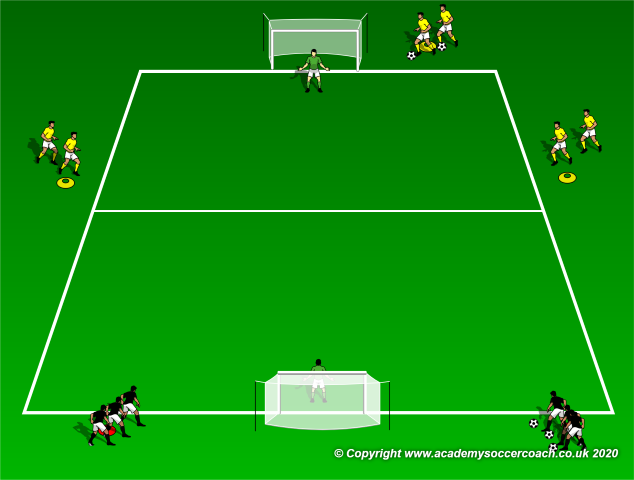
The setup of the exercise. The black team starts the attack.
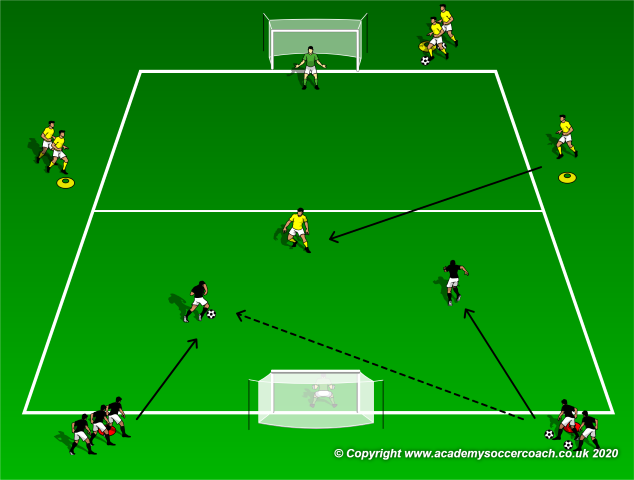
The black team starts in a 2v1 attack situation against the yellows.
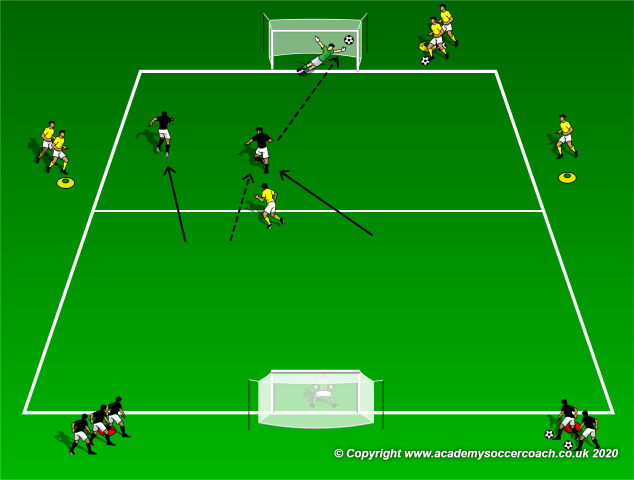
The attack is concluded from inside the black team’s attacking half.
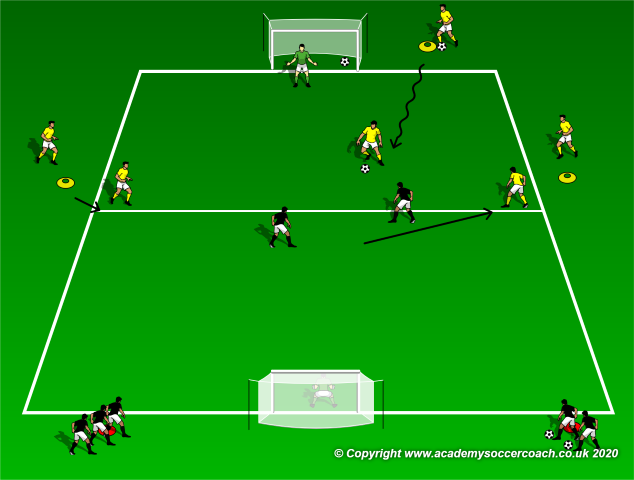
Immediately as the attack is over, the yellow team starts to attack in the opposite direction in a 3v2 situation.
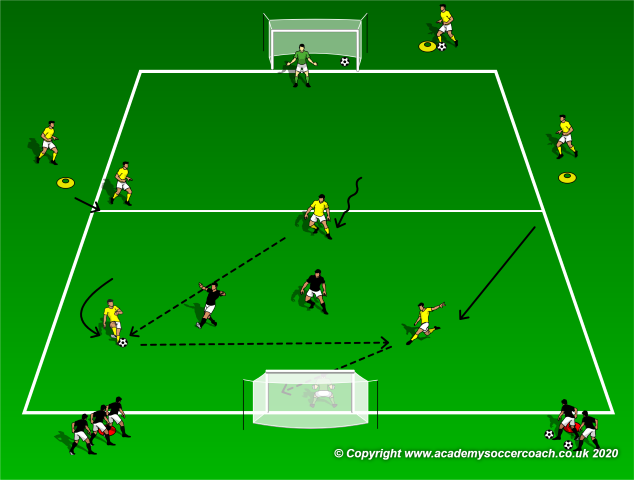
The yellow team concludes their attack. Therefore now a new attack involving different players from both teams take place.
Progression: Both teams have an allotted time to conclude at goal. The two blacks against the yellow have a maximum of eight seconds to score, while the yellows have a maximum of ten seconds against the blacks.
By Philip Cauchi
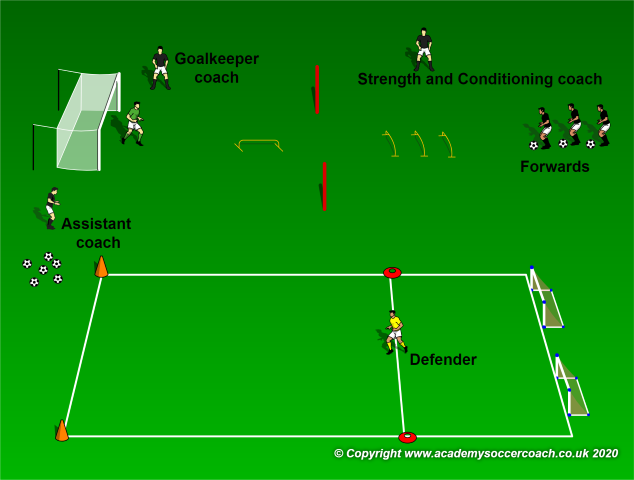
Attacking and Conditioning Drills
By Philip Cauchi
Title: Combined technique and strength endurance.
Theme: Applied strength.
Development of the soccer domains:
Technical: Attacking heading, aerial passing, dribbling, feints/fakes, and tackling.
Tactical: Defending 1v1.
Mental: Concentration, quick shift of focus (attacking in a 1v1 after heading the ball) and attitude to the positive or negative transition if the defender wins the ball in the 1v1.
Physical: Strength endurance for the lower body.
Organisation: The practice is specifically designed for forwards. We have a group of forwards in a line approximately 30 yards in front of the goal. Three hurdles (approximately 12 inches in height) are positioned in front of each other and a pole is positioned 8 yards to the both sides of the hurdles. Another hurdle is positioned 10 yards in front of the three hurdles. A goalkeeper is in goal, and we also have a pitch measuring 20 yards in length x 10 yards in width marked for the 1v1. Two mini goals are positioned on the goal line at one end while a gate is set for the counter attack (should the defender wins possession of the ball) at the opposite end.
Training load: 2 series of 6 repetitions each, with a rest of three minutes between series. The players should rest for one minute between repetitions. The work to rest ratio should be approximately from 1:4 to 1:5. The duration of each repetition should not be more than 20 seconds in total.
Periodization: This practice should be carried out on the strength day which should not be less than 72 hours following the previous match (MD+3) and at least 72 hours prior to the next one (MD-3). This applies for the players who have played for more than 60 minutes (depending on the intensity of the match) in the last match. The players who did not play or played just a small part, can perform this session even in the day following the match.
Targeted energy system: Anaerobic lactic (high speed of muscular contractions with incomplete recoveries).
Training considerations: The players should be thoroughly warmed up before this practice with special attention given to dynamic flexibility and mobility of the lower limbs.

The setup of the exercise. In the 1v1 exercise the defender must start on the marked line.
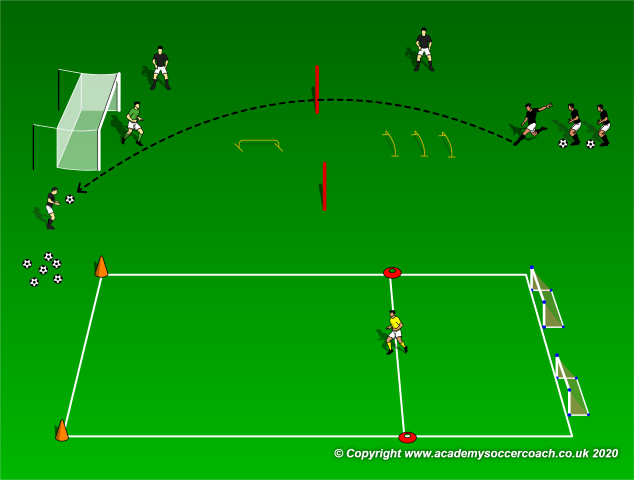
The forward plays a medium high pass to the assistant coach.
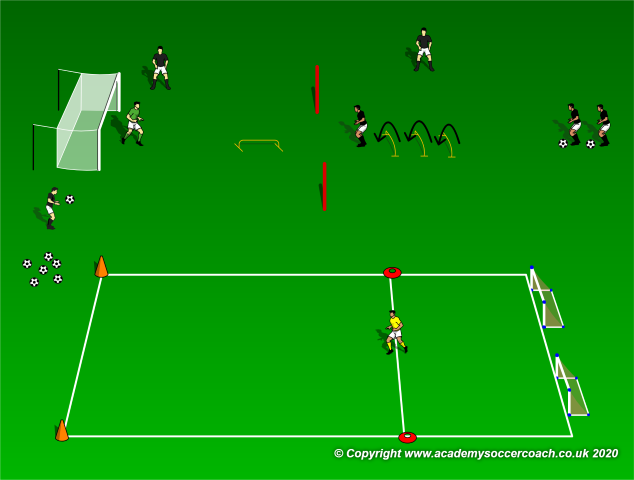
Following the pass, the forward performs three sequential high jumps over the hurdles.
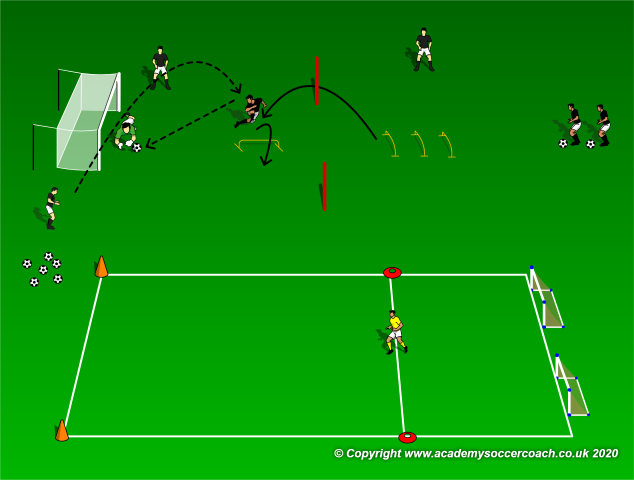
This is followed by running fast around the far pole and jumping over the hurdle (should be lower than the previous three hurdles) to finish the ball served by the coach with a header on goal. The coach serves from the right of the goal in the first series and then from the left in the second.
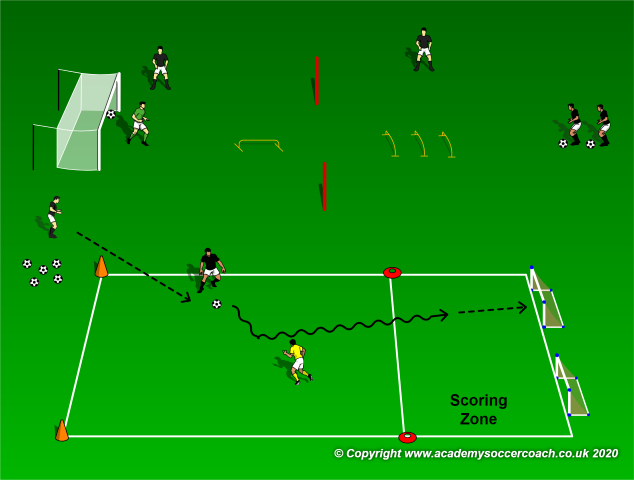
Immediately the forward receives the ball passed on the ground to play a 1v1 against the defender. The forward can only score from inside the marked scoring zone, while the defender scores (if he wins the ball) by dribbling between the two orange cones. The total duration of the exercise should not take more than 20 seconds, otherwise the exercise stops. Therefore, the offensive dribbling by the forward must be direct. When the attack is over the forward becomes a defender. After defending, the forward must again join the end of the line of forwards.
Variations:
1. Remove the 1v1.
2. Remove the single hurdle the forward jumps over to head the ball.
3. The pass from the forward to the assistant coach is played on the ground.
4. The forward concludes with a volley instead of a header.
Progressions:
1. Increase the number of sequential jumps
2. The forwards jump laterally.
By Philip Cauchi
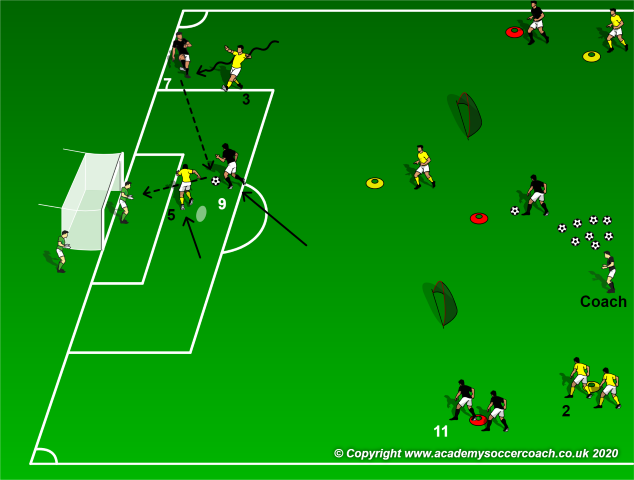
Conditioning With Attack v Defense
By Philip Cauchi
Title: Position specific explosiveness.
Theme: Applied power.
Development of the soccer domains:
Technical: Medium range passing, oriented first touch, dribbling forward at speed, tackling, crossing (including cut back passes) and finishing.
Tactical: Attacking down the flanks and getting unmarked inside the penalty area.
Mental: Quick decision-making of how to create space, get unmarked and when to attack the space created.
Physical: Explosive movements with changes of direction to attack the ball.
Organisation: The practice takes place in one half of the pitch. We have a goalkeeper in goal, a full back on both sides and a central defender. The attacking team has a striker and a winger on both sides. Two mini goals are positioned 15 yards in front of the penalty area. If the defenders win the ball, they counter on the two mini goals.
Training load: 2 series of 6 to 8 repetitions each. Rest for one minute between repetitions and for four minutes between series. We aim for a work to rest ratio of approximately 1:10.
Periodization: The exercise should be carried out on the speed and power day, not less than 48 hours prior to the match (MD-2).
Targeted energy system: Anaerobic alactic (high quality football actions with minimal accumulation of lactic acid).
Training considerations: The players should be thoroughly warmed up before this practice with specific attention given to dynamic flexibility of the lower limbs.
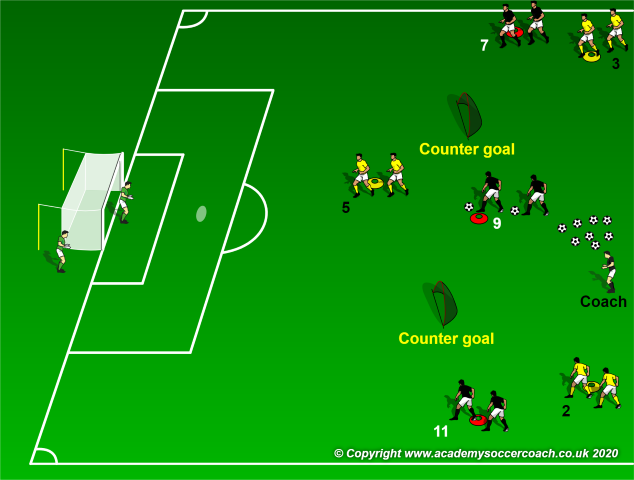
The play always starts from the striker’s position (black 9) who passes to either side (winger 7 or winger 11) depending on which winger has to go next.
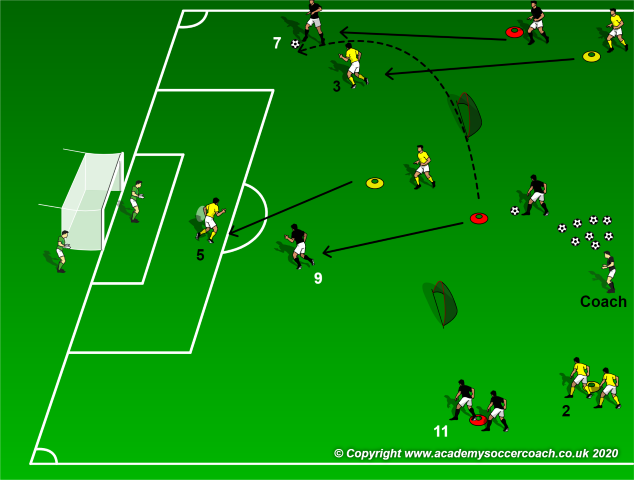
The striker (black 9) passes to the winger (black 7). At that moment the central defender (yellow 5) and the striker (black 9) move into the penalty area. The full back (yellow 3) trails behind the winger (black 7) who defends against the latter to prevent the cross.

The winger plays the cross for the striker to finish on target. Should the defender or the goalkeeper win the ball, the defending team quickly counters on the two mini goals.
Progressions:
1. The winger can opt to play the cross or dribble towards the inside.
2. When the ball is played on one flank, the opposite winger attacks while the opposite full back defends. Thus making the situation a 2v2 inside the penalty area. The winger on the ball can decide to either play the cross, a cut-back pass or dribble diagonally towards the centre.
By Philip Cauchi
